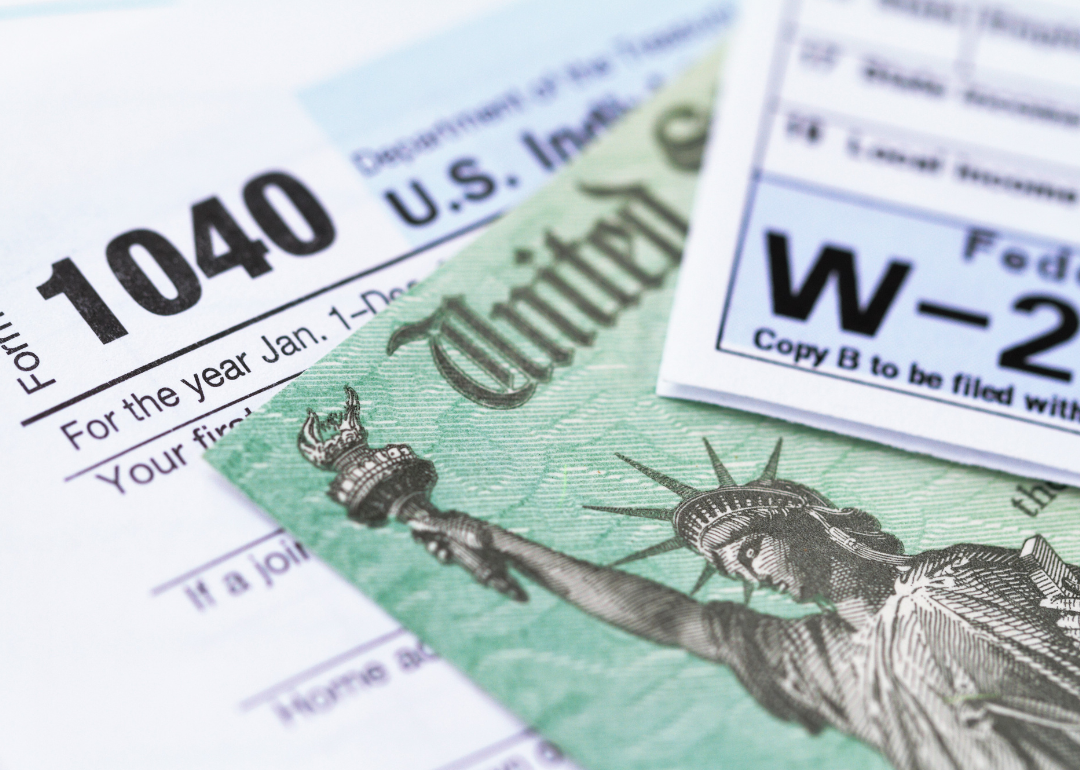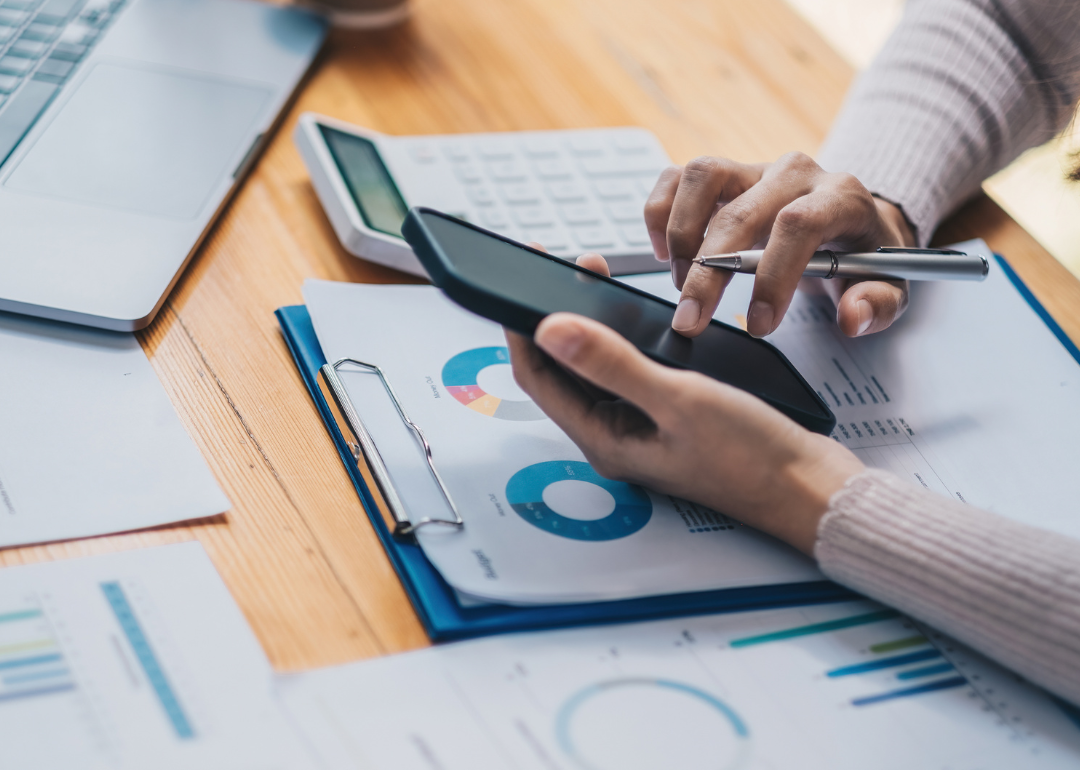5 ways to invest your tax refund and boost your financial well-being

Canva
5 ways to invest your tax refund and boost your financial well-being
Close up of tax forms and check from the US Treasury.
Millions of Americans will receive a tax refund when they file their taxes this year, giving them a nice cash boost that can help improve their financial lives. The average tax refund is $2,933 as of March 17, according to the IRS, so the money taxpayers receive can be substantial.
Even though the idea of spending it may be tempting, there are many great ways to use your tax refund including boosting your savings, investing it in a side hustle or reducing debt. Bankrate compiled 5 smart ways to put your tax refund to work. And if you’re still unsure what to do with it, consider consulting with a financial advisor to help decide the best way to put your money to work.
Key tax refund statistics
- 75% of U.S. adults who expect a tax refund say it’s important to their overall financial situation, according to a Bankrate survey.
- One-third of Americans are worried their refund will be smaller than usual, the Bankrate survey found.
- Just 5% of Americans said they plan to invest their tax refund, according to the Bankrate survey.
- The average tax refund was $2,933 as of March 17, 2023, according to the IRS, down 11.3% from $3,305 at the same time in 2022.
- The IRS had processed 53.9 million refunds as of March 17 and had refunded about $158.1 billion to taxpayers.
- About 97% of tax refunds were issued through direct deposit, as of March 17, according to the IRS.
![]()

Canva
1. Boost your emergency fund
A person divides money into piles at a coffee table.
There’s some debate which should be done first — paying off high-interest debt or having an emergency fund. At least, starting an emergency fund should be a top priority — and then the rest can be applied toward debt or other priorities.
Achieving financial security requires planning for unexpected events. A recent Bankrate survey found less than 40% of Americans could pay an unexpected $1,000 expense from a savings account. So, setting up (or boosting) an emergency savings account is a key part of a smart financial plan.
“That way you cover any ‘what ifs’ or anything that could potentially derail your budget and get you further into debt,” says Cynthia Flannigan, certified financial planner at MainStreet Financial.
That’s why if you’re going to put your money into savings, make sure you’re putting it in an account that’s going to earn the most interest. Comparatively, if you were getting the national average savings yield of 0.23% APY, you’d earn less than $7 after a year.
In five years that starts adding up — or not. Assuming the variable APYs stayed the same, you’d earn about $600 more in the higher-yielding account over that period.
“We recommend an online, high-yield savings account — so that it’s far enough away from your regular spending that you won’t tap into it, but it’s there if you need it,” Flannigan says.
Savings accounts aren’t meant to be transaction accounts. If you need the ability to write a limited number of checks from savings, look for a money market account that offers check-writing privileges, in addition to a competitive APY.

Canva
2. Contribute to an IRA
A couple review financial documents at a table.
If you’ve already filed your return, it’s too late to contribute to an individual retirement account for the 2022 tax year, unless you want to file an amended return. But you can take your refund and put it into a traditional IRA for the current tax year, plus what’s in the account can compound tax-free until you withdraw it, and the contribution may reduce your 2023 taxable income.
If you’re eligible to contribute to an IRA, be aware of contribution limits: $6,000 for 2022 for most filers; $7,000 for those 50 and older. In 2023, the limits increase to $6,500 or $7,500 if you’re age 50 or older. An IRA contribution can help you boost your retirement balance — and may be a good option, especially if you have sufficient emergency savings, don’t have credit card debt or similar at a high APR and you’ve maximized your 401(k) contributions.

Canva
3. Pay off debt
A couple sits at a table reviewing financial papers.
The average APR on variable-rate credit cards is 20.05%, according to Bankrate data. Using your tax refund to pay off high-interest debt could be the best use of the money. The average balance on credit cards was $5,910, according to Experian data from the third quarter of 2022. If you paid only $100 a month toward the $5,910 balance it would take 265 months to pay off and cost an additional $20,517 in interest.
Paying down debt is the top priority for Americans who expect a tax refund in 2023, according to a recent Bankrate survey. About 28% intend to use their tax refund to pay down debt, up from 23% last year. Advisors suggest focusing on paying off high-interest debt first because of the weight it can have on your finances.
“That’s the most expensive and worst kind of debt, typically,” says Liz Landau, a certified financial planner at Landau Advisory in White Plains, New York. “So that’s usually the first thing I’ll suggest with a refund.”
MainStreet Financial’s Flannigan says there are two ways to approach paying off debt:
- Avalanche method: Focus on paying off the debt with the highest interest rate. Once that is paid off, move on to the balance with the next-highest rate. This method saves the most money.
- Snowball method: Pay off the smallest balance first for the sense of accomplishment, and then work your way up until you finish.
The snowball and avalanche methods can both be effective ways to pay down debt. The avalanche method is likely to save the most money because you’re paying down high-interest debt first, whereas the snowball method is more about psychological gains that come from paying off small balances first.
Other tips for paying off debt include paying more than the monthly minimum, paying more often than once a month and sticking to a regular budget to help manage expenses.

Canva
4. Contribute to a savings account to save for key goals
A couple sits in a living room opening moving boxes.
If you already have an emergency fund and you’ve either applied money toward debt or don’t have any debt, then consider putting at least some of your tax refund into a high-yield savings account. It could be money that’s earmarked for a down payment on a home, a wedding or saving for a vacation.
About 26% of Americans said they plan to use their tax refund to boost their savings, according to Bankrate’s survey, the second-highest use behind paying down debt. Contributing $3,000 to a high-yield savings account yielding 4% would leave you with $3,650 after 5 years.
You don’t have to earmark a savings account now. Your life goals will probably change as you age. So just having that money in your savings account will allow you to easily adapt as priorities shift. You can either lump all your savings into a single account or place funds in separate high-yield savings accounts to make sure that money meant for one purpose doesn’t get casually used for something else. Be sure to hold your emergency fund in a high-yield savings account, so you’re getting the best interest rate that’s available while still having regular access to the money.
To get the highest APY, banks used to offer tiered balances to encourage customers to put all their money in a single institution. But now online banks, generally, offer the best APYs and require low or no minimum balance in return. There are several online banks with competitive yields that have no or low minimum balance requirements.

Canva
5. Investing and building wealth
Close up of person at a desk using a calculator.
Investing is a key part of building wealth and saving for long-term goals such as retirement, so using your tax refund to invest can be a great choice. Securities such as stocks and bonds can be used to build a diversified portfolio that can grow significantly over time.
Mutual funds and ETFs can be used to build diversified portfolios at a low cost, so you won’t have to worry about choosing which individual stocks or bonds to buy. Most online brokers allow you to get started with just a few dollars, so don’t worry if you don’t have much to invest initially.
You might also consider using a robo-advisor, which helps build an investment portfolio based on your goals and risk tolerance, but charges a much smaller fee than traditional financial advisors. The top robo-advisors have investment apps that make it easy to track your portfolio from your phone.
The key distinction between using your tax refund for investing in assets like stocks versus using it to save is the amount of risk involved. Stocks are volatile in the short term, so only invest the money if you’re confident you won’t need it for the next five years or so. If you may need the money, a high-yield savings account is likely a better choice.
Additional tax refund resources
“Ultimately, you have to ask yourself what’ll make you feel better in the long run,” Flannigan says. If in the future you’d like a smaller refund, she says you could increase your withholding allowances.
“So, less income tax will be withheld, your refund will be smaller, but your monthly paycheck will be larger and you’ll be able to spend that money on your goals instead,” Flannigan says. Or you can think of your tax refund like it’s forced savings.
This story originally appeared on Bankrate and has been independently reviewed to meet journalistic standards.
